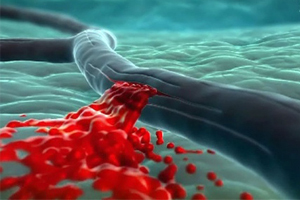Not everyone knows why there are strokes ischemic and hemorrhagic, unlike these diseases from each other and what are the possible consequences. It's 2 different neurological diseases. They are united by the fact that in both cases there is an acute ischemia of brain tissue as a result of circulatory disorders. Stroke is an emergency. When delayed medical care possible death.

Causes of
The first difference hemorrhagic stroke from ischemic - in the etiology (causes of). hemorrhagic stroke otherwise it called a cerebral hemorrhage. The basis of brain damage based on the following processes: vascular damage, insufficient blood flow and impregnate it organ tissues.
The reasons could be:
- Aneurysm of cerebral vessels. At this pathology artery wall bulges outwardly. This condition is congenital and acquired. Causes aneurysms are: brain malformations (abnormal communication vessels) connective tissue dysplasia, high pressure, hyalinosis of vascular, traumatic brain injury, and atherosclerosis. Contributes to breaking the sharp increase in blood pressure, stress and strain.
- High blood pressure. Hypertension can result from pathology of the central nervous system (polyneuropathy, meningitis, encephalitis, tumors), renal disease (glomerulonephritis, chronic pyelonephritis, renal vascular thrombosis, congenital anomalies, and hydronephrosis Nephroptosis), endocrine disorders (pheochromocytoma, hyperthyroidism), narrowing of the arteries, vasculitis, coarctation of the aorta and atherosclerosis. High pressure favors damage to the artery walls.
- Inflammatory diseases of vessels feeding the brain.
- Inefficient use of medications (anticoagulants, fibrinolytics).
- Problems with blood clotting.
- Use of drugs.
- Amyloid angiopathy.

In the development of cerebral infarction (ischemic stroke) Are other processes. The causes of this disease include:
- Heart disease (myocardial infarction, atrial fibrillation, congestive heart failure). When organ dysfunction decreased cardiac output and decreased blood flow to the brain.
- Diabetes.
- The defeat of the cerebral artery atherosclerotic plaques. The latter are formed in people with dyslipidemia (disorders of lipid metabolism) and obesity. A risk factor is improper nutrition. Atherosclerosis develops in the abuse of food, rich in animal fats and simple carbohydrates.
- Smoking. Promotes endothelial damage arteries.
- Psycho-emotional stress (stress). Against the background of experiences adrenal system is activated, resulting in the blood is thrown out a lot of catecholamines. These hormones constrict vessels, impairing blood flow to the brain.
- The increased pressure (more than 139/89 mm Hg).
- Frequent hypertensive crises.
- Spasm of the carotid arteries.
Often cerebral ischemia occurs in people with cervical osteochondrosis.
Signs and symptoms
There is a difference between ischemic and hemorrhagic stroke in symptoms. For cerebral hemorrhage is characterized by:
- Strong headache;
- dizziness;
- vomiting;
- nausea;
- disturbance of consciousness (stunning, stupor or coma);
- behavioral change;
- memory disorder;
- speech and sensory disorders;
- paresis;
- meningeal symptoms (Kernig, Brudzinskogo, stiff neck muscles);
- stem symptoms;
- convulsions.

Hemorrhagic stroke differs from ischemic fact that in the first 2-3 weeks of developing cerebral edema. Often there is a dislocation syndrome. The reason - the displacement of brain structures due to the formation of hematoma (cavity with blood). When cerebral infarction often experience the following symptoms:
- speech impairment;
- drooping corner of the mouth;
- facial asymmetry;
- anesthesia (loss of feeling);
- hemiparesis;
- lack of understanding of a foreign language;
- difficulty swallowing (observed in the case of cerebellar lesions);
- nausea, hiccups and vomiting;
- incoordination;
- dysarthria (difficulty speaking the words);
- motility disorders (apraxia);
- anosognosia (unawareness of human diseases);
- ocular symptoms (bilateral blindness, flash before his eyes, visual hallucinations).
Ischemic stroke is characterized by hemorrhagic fact that the clinical picture depends on the level of brain damage. For disease diagnosis methods include MRI, CT, scintigraphy, Doppler, EEG, ECG, general clinical analyzes, coagulation, neurological examination, physical examination, and biochemical analysis blood. Differences in diagnosis are not available.
First aid and treatment
The difference between hemorrhagic and ischemic stroke lies in the treatment. If you suspect a stroke, you must:
- Call an ambulance.
- Do not give a person to eat and drink. When dysphagia food can get into the respiratory tract and cause asphyxia.
- Remove constraining clothing.
- Open the window and provide a flow of oxygen.
- Give the patient the desired position. If the person is unconscious, but breathing it is stored, it is required to lay it on its side. In this case, the head should be lifted, and lay on his arm. Legs bent at the knees.
- Conduct resuscitation (artificial respiration and chest compressions).
- Clear the upper airways of mucus and vomit.
- Monitor the status of the person to the arrival of an ambulance (to measure the pressure, take the pulse and respiratory rate).

These activities are carried out regardless of the type of stroke. Further medical tactics may differ. By the features of cerebral infarction treatment include:
- The use of antiplatelet agents and anticoagulants. These medicines are prescribed to thin the blood in the case of thrombosis and enhanced coagulation. Used drugs such as Clopidogrel, Lopirel, Plavix, Fraksiparin, Dipyridamole-FPO, chimes, Heparin and Warfarin. In hemorrhagic stroke, these drugs are contraindicated.
- Neuroprotection (improvement of the brain). In acute ischemia apply antioxidants (Meksidol), improving agents metabolic processes (meldonium, Glycine, Mildronate, Melfor, and Kardionat Medatern), cardiovascular preparations (Pentoxifylline, Trental, Fleksital, Cavinton, Vinpocetine), adaptogens (Apilak, tincture Eleutherococcus), a combination of drugs (Fezam, Tiotsetam) and nootropics (piracetam, Lutset, Cerebrolysin, Semaks). Most of these drugs are contraindicated in cerebral hemorrhage.
- The use of statins. They are shown in stroke on the background of systemic or cerebral atherosclerosis, dyslipidemia and family. Apply: Simvor, Roxer, Atomaks, Lipitor and Rozukard.
- Using thrombolytics (streptokinase).
- The need to comply with strict diet (atherosclerosis). There is a whole table with a list of permitted and prohibited foods and dishes. The most important aspect of power is rejection of fatty and fried foods, bakery products and sweets.
- The operation. Ischemic stroke forms differ in that when removing them may require thrombus (thrombectomy, thrombolysis), purification vessels of atherosclerotic plaques, stenting and angioplasty.
Treatment of the hemorrhagic stroke is directed to stop bleeding and hematoma removal. Antihypertensives apply (with increased blood pressure) and haemostatics (Vikasol). When cerebral edema shown diuretics (Torasemide, Diuver, Furosemide), magnesium sulfate solution and systemic corticosteroids (prednisolone). Hemorrhage into the brain may require surgery (set to aneurysm clips), and embolization removal malformations (vascular shutdown of blood flow).
In ischemic and hemorrhagic stroke necessarily need rehabilitation. After medical and surgical care effective massage, physiotherapy, exercise (physiotherapy), speech development when aid classes with a speech therapist, rest in a sanatorium, gidroprotsedury, psychotherapy, nutrition, vitamins and minerals additives.
Difference from ischemic stroke is hemorrhagic lower percentage mortality (15-20%). Hemorrhage this figure reaches 70%. In half of the people die after surgery for removal of the hematoma. In both cases, many patients remain disabled for many years. They can voice disorders and movement disorders in the form of paralysis and paresis.



